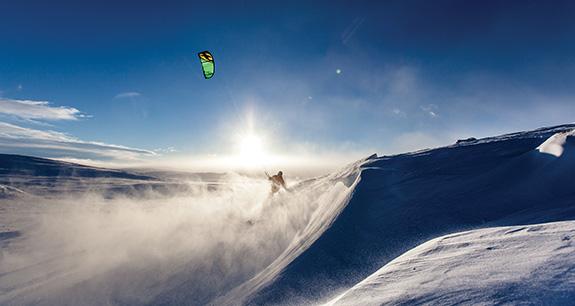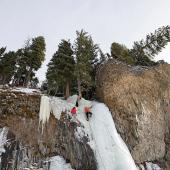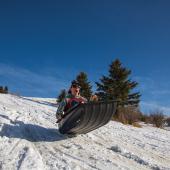On a Wing and a Prayer
Snowkiting in Montana.
The temperature lingered just above zero while the wind howled and gusted well over 30 miles per hour. The snow was deep and the ground blizzard felt like a firestorm of white. Overhead, I could see glimpses of blue sky, but at ground level the visibility was under 100 yards. I was flying my smallest kite, a seven-meter Ozone Subzero, speeding uphill into an imposing whiteout at a solid clip. Kite-skiing in the lee of corniced gullies, powder flowed to my waist and sometimes over my shoulders. Giddy with excitement, I rode lap after lap in these deposition areas, relishing the feeling of weightlessness as I floated downhill, finding the deep, untracked cold smoke of winter. As the hours progressed, I moved from one canyon to the next, each one getting steeper, deeper, and requiring more and more commitment as I ventured further from the road.
Over one hill and down the next, I spotted a red fox, frightened by my presence and running as fast as possible to elude my approach. The cornices were getting bigger and signs of recent wind-loading suggested that cornice failures could be probable. “Terrain trap,” I said to myself, mindful of the hulking masses of snow without first inspecting the terrain below. Toward early evening, the wind speed slowly abated and the visibility improved. I now had views east, deep into Montana’s snowbound Centennial Valley. Familiar landmarks became visible as I kited: Antone and Antelope peaks, and, barely visible to the north, the dark volcanic plug of 10,500-foot Black Butte. Far away on the eastern horizon, the magnificent Madison Range showed the alpenglow of sunset. Seeing this spectacular snow-covered landscape was my reward for being out on this winter day and will preoccupy my memory for months to come.
During the long winter of the Northern Rockies, for most people, when a cold wind blows, it’s time to remain inside and shut the door to nature’s relentless fury. Few people welcome the driving wind of a winter’s day. Even hardcore skiers will wait out a storm and not until after the snow settles seek out the guarantee of wind-filled powder stashes. However, there is a niche of hardy winter-sport enthusiasts that look forward to the onslaught of winter’s wrath. We are the snowkiters.
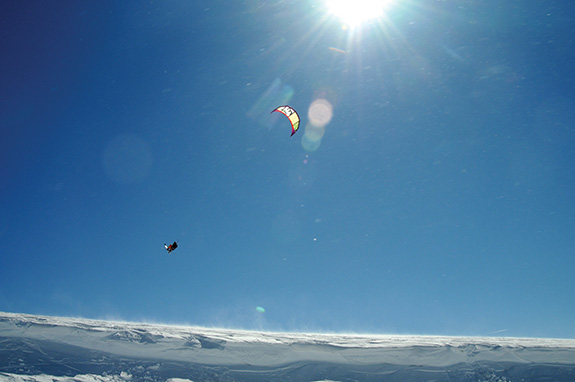
Snowkiting is a relatively new sport. In Montana, it has been practiced for about 15 years by a small group of skiers and snowboarders. Many areas of Montana (and neighboring Idaho and Wyoming) are perfectly suited to this sport. As snowkiters, we seek out large expanses of treeless, snow-covered terrain. With the power of our portable wings, the snowy landscape becomes a vast playground for ripping untracked lines. Kiting breaks all the rules: uphill, downhill, and across snowy mountainsides—we are no longer confined to a crowded lift-served ski resort. As kiters we are free to explore the snowy world around us and enjoy a unique high-speed, adrenaline-charged freedom that often feels limitless. Terrain features add to the excitement: wind-lips, gullies, and cornices provide a draw to pull the trigger and “send it” for lofty airs. Huge boosts are easy when loading up an edge on the snow and every freestyle move feels a notch more exciting when performed on a powder day. With the right skill, focus, wind, and terrain, kiters can pull off paragliding-like flights that defy gravity.
Snowkiting is not for everyone. It’s often practiced in unbearably cold, isolated locations and at high altitude where it’s quite possible to push a heart rate well into the red zone. Pilot mistakes are unforgiving and failure to finish a boost cleanly is usually met with unimpeded impact into terra firma. Even park-and-ride sessions have an element of risk. There is little to no safety net when snowkiting (except what one brings for oneself), even when just a short distance from the highway.
The treasure of snowkiting in the mountains is the ability to always find new and breathtaking places to practice this sport. Expansive snow-covered public lands seem to offer a never-ending supply of new sessions; many of these are right off the highway and offer easy access without many complications. Other, more remote spots may require snowmobiles, a higher level of commitment, and mountaineering knowledge to access the isolated backcountry of the Rocky Mountains.
Private ranch lands are particularly special for kiting. When scouting kiting spots, it’s quickly recognizable that some places are better than others. Wind direction, strength, fetch, snow cover, and access are all important. More often than not, the perfect spots seem to be on the property of private owners. However tempting, it’s essential to get permission. The secret is to ask first rather than poach and ask for forgiveness later. Many times I have driven up to an isolated ranch house, walked to the front door and knocked. “Sure you can fly a kite on my ranch; don’t bother me none,” is the reply I commonly receive. Introducing myself to a local rancher, asking and getting permission to kite on his or her land, and having a fantastic day on a snowy landscape is an extraordinary adventure in and of itself. It even provides entertainment for the locals as they watch in amazement as we rip up their powder, boosting big airs, slicing up snowy wind-lips, and showing off for an appreciative audience.
While snowkiting can be adrenaline-fueled and fast-paced, there is definitely a meditative side as well. Cruising silently across a snow-covered field and feeling the steady pull of a wind-powered wing is quite relaxing. As a terrestrial sport, snowkiting provides a very different feeling than kiting on water. Swift, silent, and peaceful, the movement allows us to look around at the ever-changing views and enjoy the ride. The sport is quite multi-faceted: one minute you can be smoothly climbing a windy mountainside; the next, you’re intensely charged with the excitement of a gravity-filled descent in untracked powder.
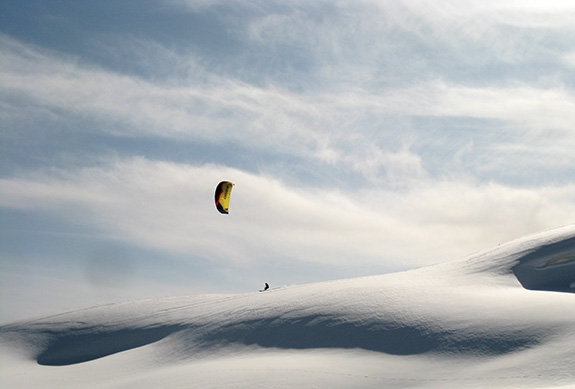
Huge distances can be racked up from a day of snowkiting. A couple three-hour sessions on a properly powered kite and you can easily cover 50 to 60 miles. Oddly enough, all that mileage might only be in a relatively small section of land. When one finds an area of perfect wind direction, proper wind strength, powder snow, and fun terrain, there is no reason to go any further. A kiter can do laps all day long.
In this day and age, it’s easy to find other kiters through social media, especially in the Rockies. In Montana, there are always kiters getting together for sessions. Weekdays, weekends, week-long road trips: if the conditions are on, there are kiters getting after it. Every year we all get together for the annual Montana Snowkite Rodeo. Now in its 16th year, this rowdy event brings together kiters from around the U.S. and Canada for three days of product demos, a winduro race, a poker run, kite touring, and lots of freestyle shredding. For a state as big as it is, Montana’s kite community is tight, well-connected, and very supportive.
The pleasure that comes from being fully powered and exploring snow-covered terrain is without equal. Harnessing the wind as you effortlessly ride uphill is like cheating some basic rule of physics, or nature itself. The satisfaction that comes from exploring a new kiting spot, riding with friends, and slaying lap after lap of untracked powder totally corrupts one’s sense of time, space, and distance. Every winter there is a steady, incremental progression of individual skills, while new adventures await the unexplored and untested kite spots deep within the high mountains of the region. Even with well over a decade of kiting, there are still many locations that have never been kited. So whether you are an experienced kiter or new to the sport, if you can embrace the challenges of winter in the backcountry, the elements that make for a wild and wonderful snowkiting experience are waiting and well within reach.
Noah Poritz has been chronicling snow kiting in Montana, Idaho, and Wyoming since 2002. A Team Rider for Ozone kites, Noah has pioneered scores of snowkite locations throughout the region.

